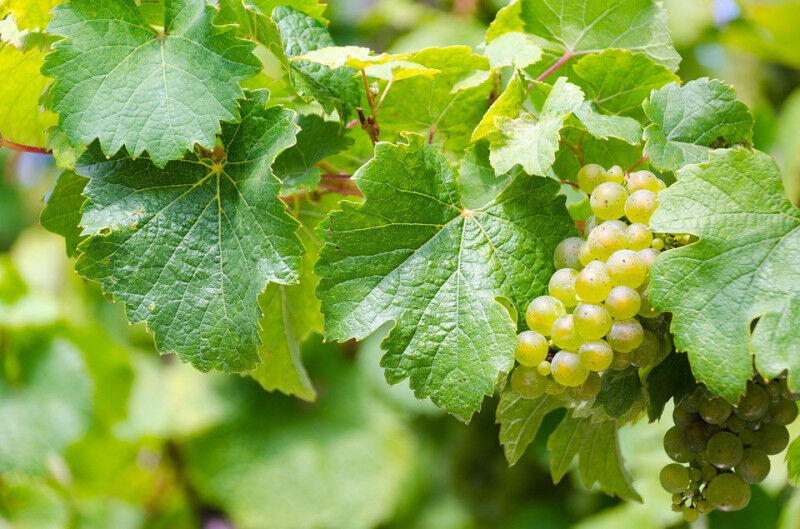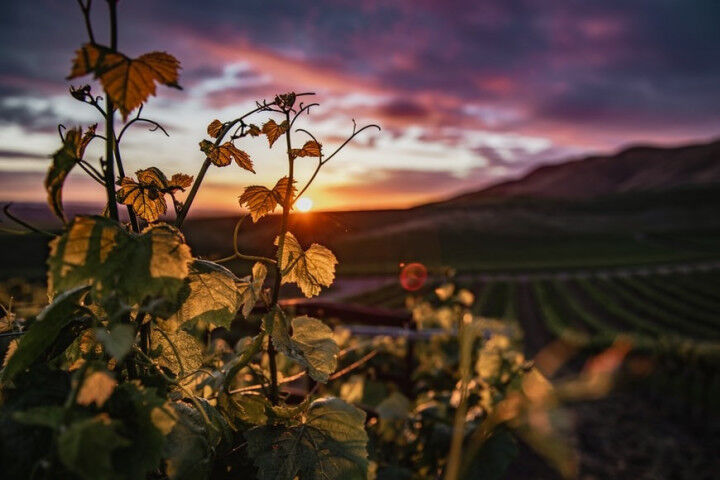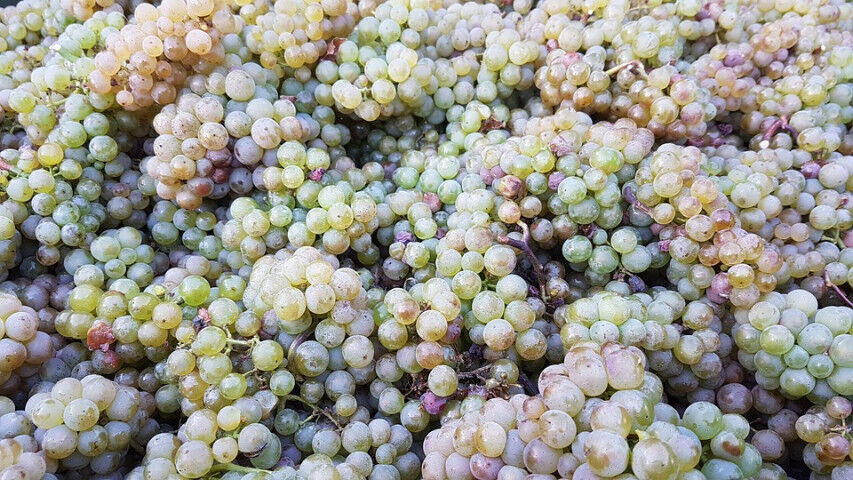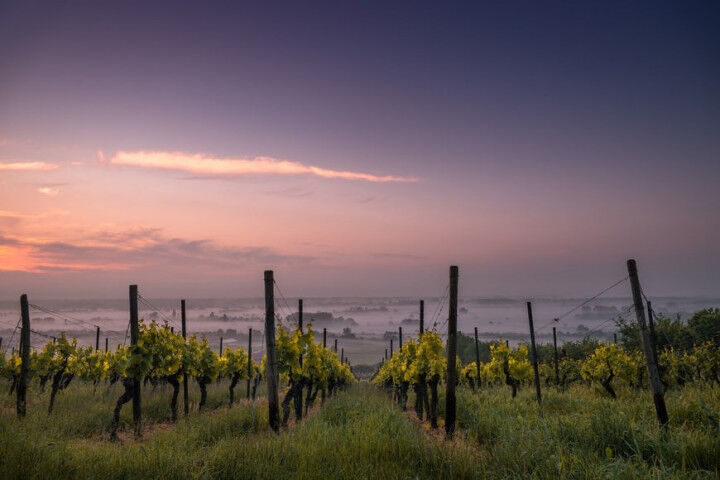Riesling and Moscato
The Riesling and Moscato grapes are similar in that both are very aromatic varieties, and this characteristic is a signature feature for both. Riesling is known for its lemon and lime aromas plus, when aged, petrol notes. Moscato is fragrantly floral and peachy.
Both appear in dry and sweet, still or sparkling styles, and both produce fresh white wines. Where these cultivars differ is their planting quantities in Italy. Moscato exceeds Riesling in cultivation (hectare details below). Additionally, the wines made from each of these grapes age uniquely; Riesling can last for years while Moscato favors early drinking. What’s more, they have different profiles so pair with different foods. If you want to find out how to choose between Riesling and Moscato, you’re in the right place!
Riesling
Main characteristics of Riesling
- Riesling comes from the Rhine in Germany.
- It displays aromas/ flavors of lime, lemon, florals, petrol, kerosene, wax, and honey.
- In its homeland, Riesling comes in bone dry to lusciously sweet styles.
- It has naturally high acidity even when fruit is left on the vine for late harvest so can age for years. Certain styles are also perfect for early drinking.
- It covers 446 hectares in Italy.
- Its chief areas of cultivation are Lombardia, Toscana, Trentino, Alto-Adige, Veneto, and Puglia.
- Italian Alpine Riesling is one of the finest expressions of the grape.
Examples of Riesling:
- Hérzu, Ettore Germano, Langhe, Italy.
- Riesling Kaiton, Kuenhof, Alto Adige, Italy.
- Schulz, Roncodel Gelso, Friuli-Venezia Giulia, Italy.
Moscato
It’s hard to know where to begin with Moscato (or Muscat) simply because the name covers a sprawling family of grapes used for both still and sparkling plus dry to sweet wines. This grape is regarded as one of the oldest varieties used in winemaking and some ampelographers think it is actually the grandfather of all Vitis vinifera.
In fact, there are more than 200 varieties in the Moscato family covering the gamut of white to black grapes. One defining characteristic that runs through each Moscato cultivar is the presence of highly aromatic florals. In Italy, perhaps the most famous wine produced from this variety is Moscato d’Asti, the fragrant bubbly wine from Piedmont. It’s made with the Muscat Blanc à Petits Grains variety and is famous for its fresh stone fruit and white flower aromas, light musk, and gentle yet persistent sweetness. Other widespread varieties of Muscat include Muscat Ottonel, Muscat of Alexandria, Moscato Nero, and Moscato Rosa.
Main characteristics of Moscato
- The Muscat family appears all over the globe under hundreds of names.
- In Italy, Muscat Blanc à Petits Grains (known locally as Moscato Bianco) displays peach, florals, musky, and grapey aromas flavors, and medium acidity.
- It’s used in the production of Asti Spumante Moscato d’Asti which is a low-alcohol, sweet bubbly wine.
- It’s also made in dry style (Muscat de Chambave from the Aosta Valley), passito (Calabria), and fortified styles (Sardinia) in Italy.
- This variety covers 3,538 hectares in Italy.
- It produces DOC and DOCG wines.
Examples of Moscato
- Moscato d’Asti, G.D. Vajra, Piedmont, Italy.
- Moscato di Sardegna, Siddùra Nùali Passito, Sardinia, Italy.
- Chambave Muscat, La Vrille, Aosta Valley, Italy.
Riesling vs Moscato: Origin
Riesling
Riesling has a long backstory in Germany’s Rhineland, first appearing in a 13th-century reference in what is now known as the Rheinhessen region. After this date, its name became a regular in wine records in the rich wine-producing areas that follow the Rhine river. This grape also thrives in neighboring Austria and the Alsace region in France where its name has also come up in early winemaking and commercial documents. As with so many of the oldest grapes, researchers haven’t pinpointed the precise beginnings of Riesling but there’s a lot of evidence to suggest that it was born in the Rhine from a cross between a grape known as Gouais Blanc (or Weisser Heunisch) and an unnamed wild wine crossed with Traminer.
Further delving into Riesling’s roots hints that it could have been born somewhere around the Adriatic. Whatever its origins, Riesling has long been synonymous with fine German winemaking and it’s no surprise that some of its best expressions come from northern Italy where it flourishes in the lower temperatures loves.
Moscato
Some ampelographers are convinced the story of Moscato reaches back into ancient times touching on the Persians and Egyptians of old in BC times. Several other grape researchers are adamant that it was the ancient Greeks and Romans that first farmed this variety. Domestic wine production was widespread in each of these ancient civilizations and classical writers refer to sweet wines, but that’s as far as the evidence goes with the origins of Moscato.
Modern-day Moscato was first mentioned by a Franciscan scholar from England known as Bartholomeus Anglicus who referred to it in a work written around 1230 in modern-day Saxony in Germany. A translation of this work into French more than a century later saw the grape described as "vin extrait de raisins muscats". Whatever its origins, the sweet, light, floral notes of Moscato are welcome in the world of wine!
Riesling vs Moscato: Grapes
Riesling can withstand cold climes and is a late budder meaning it avoids potentially lethal spring frosts of the Rhine vineyards. It’s very terroir and vintage expressive with many a German winemaker waxing lyrical about its eloquence. It’s also famously naturally high in acidity, a feature that enables a staggered harvest for fruit with varying sugar levels and, therefore, a range of styles. Riesling can be dry, light, and fresh or richly sweet with fruit affected by noble rot. In Germany, it also comes in still and sparkling styles, the latter known as Sekt. With its proximity to Austria (another fertile setting for Riesling), it’s little surprise that the north of Italy – and particularly the northeast – is a zone for fine Riesling production.
Moscato
With so many types of Moscato in existence, it’s best to home in on the grape that makes its most famous Italian wine: Muscat Blanc à Petits Grains. This grape makes Asti wines as well as passito and fortified wines. It needs a long growing season because it buds early but ripens late and it’s also susceptible to a number of viticultural hazards so demands careful attention in the vineyard. This grape has several names and appears in sweet wines around the globe.
Moscato Bianco is the fourth most planted white grape in Italy and appears in 17 DOCs.
Riesling vs Moscato: Food Pairing
Riesling
This is a very expressive grape that boasts varying degrees of lemon, lime, honey, and petrol notes depending on its site and age. Acidity is high in this variety which means it can stay on the vine for months and develop high sugar levels while retaining freshness. Its acidity also gives it excellent age-ability and even the oldest Riesling will still taste vibrant because of this component.
Moscato
Delicate florals, peach, and honey are the signature aromas and flavors of this ancient grape varietal along with musk and, strange as it may sound, grapey notes. It tends toward a light body with medium acidity and, whether sparkling or still, is best drunk young.
Riesling
This versatile grape is famous for its green apple, lime, and floral notes. As it ages, it also develops honey, wax, and petrol tones. It has high acidity, can be dry or sweet, and has relatively low alcohol. When pairing Riesling with food, it’s important to go for dishes that complement its sweetness level (remember – the sweeter the wine, the better it goes with spicy food). It’s also worth noting that its high acidity makes it an ideal partner for fatty foods.
Dry Riesling
- Appetizers: Oysters;
- Entrées: Light chicken or fish dishes (no heavy sauces); pasta dishes with light creamy sauces; seafood pasta; seafood paella; leafy salads with feta cheese; tempura vegetables.
- Cheese: Feta, Mozzarella.
Off-dry to Sweet Riesling
- Appetizers: Crab and shrimp bruschetta;
- Entrées: Spicy Indian and Asian food; duck recipes; pork dishes; creamy risotto;
- Dessert: Lemon meringue pie; tiramisu; cheesecake; apple cobbler, pie, or baked apples; white chocolate desserts.
- Cheese: Blue cheeses.
Moscato
Moscato is fragrant, floral, and sweet or off-dry whether it’s a sparkling or still style. These features make this wine perfect for foods that are often difficult to pair. The key is to keep in mind its soft yet aromatic personality and its sweetness level when matching Moscato with cuisine.
Sparkling Moscato
- Appetizers: Spicy charcuterie; Indian finger food.
- Entrées: Light, spicy Asian cuisine.
- Desserts: Light fruity pavlova; almond cake; tiramisu.
- Cheese: White Stilton; Goat cheese.
Dry Moscato
- Appetizers: Crudités; oysters.
- Entrées: Salads; sushi; tempura vegetables; salmon.; seafood.
- Dessert: Fresh fruit salad; pannacotta.
- Cheese: Goat cheese; Pecorino.



